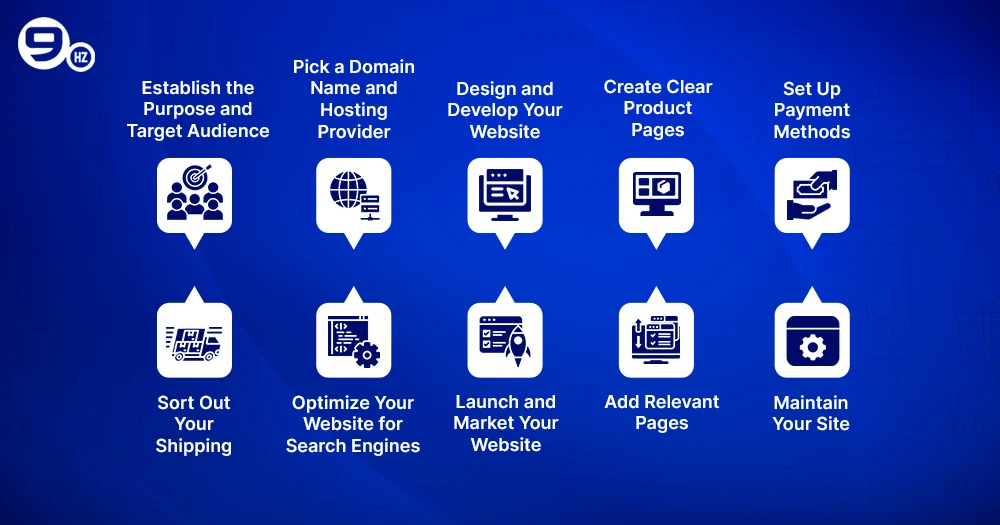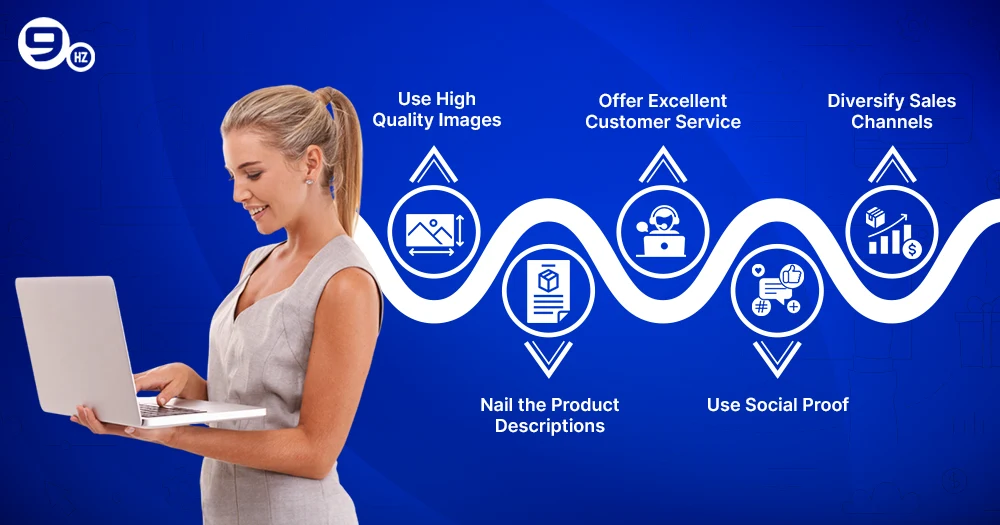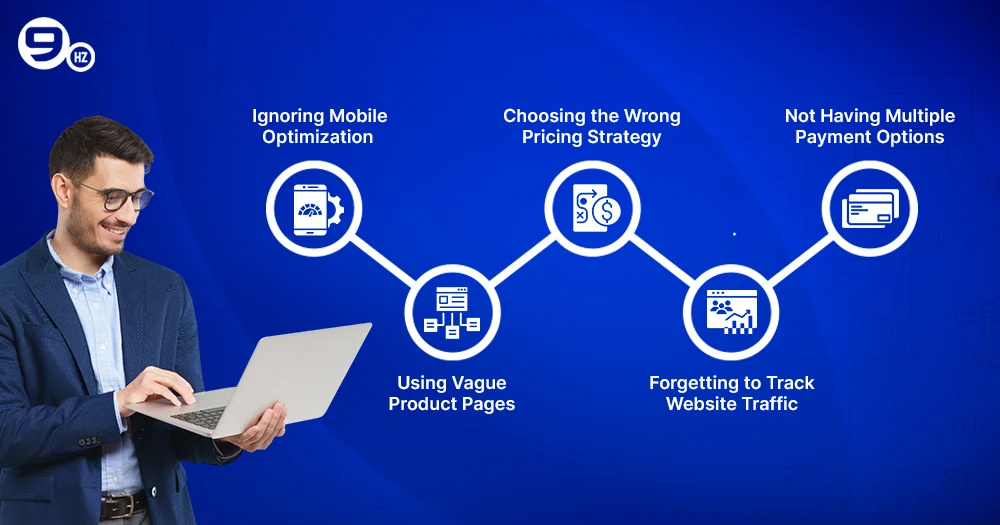Want to make money from what you love? It’s a great time to start your own website to sell products because online shopping is so popular in the US and beyond. Statista says that online sales will hit more than USD 4.3 trillion by the end of 2025, and the numbers are only going to keep going up. That means that small business owners, traders, and people who work on the side have a huge amount of opportunity.
But how do you actually create a website to sell products? Don’t worry—we have a step-by-step guide that will help you with how to make a website to sell stuff? From picking a domain name to opening a successful online store. This complete guide will teach you how to start selling online with confidence, whether you’re selling physical products, handmade goods, or digital goods.
How to Make a Website to Sell?
Before getting started, it’s important to know the basic steps for making an online store. Every step of building a profitable online store is important. From figuring out your goals and picking the right ecommerce platform to making interesting product pages and advertising your business online, each one is necessary. Let’s take a look at each step of your eCommerce journey one by one.
1. Establish the Purpose and Target Audience of Your Product
Identify your target audience and describe the goal of your ecommerce business first. Are you selling physical products, digital goods, or services with a monthly component? Who does your product help the most, and what problems does it solve?
Knowing your ideal customer will help you write product descriptions, select relevant keywords, and make your ecommerce website look appealing to potential customers. Your pricing strategy and marketing strategies will be guided by this truth in the future.
2. Pick a Domain Name and Hosting Provider
It’s time to choose a custom domain name now that you know what you’re selling and to whom. It should be short, easy to remember, and related to your business online. Your domain is the online name of your business. Next, pick a web hosting platform you can trust. Look for eCommerce platforms that provide combined solutions, such as a free domain, SSL certificate, and eCommerce template.
3. Design and Develop Your Website
When you want a website eCommerce website development company will help you to develop the website. A site that looks good and works well on mobile devices can help you get and keep online shoppers. To make the user experience smooth, use website tools and eCommerce themes that are easy to use. Website traffic and digital sales can be significantly increased by a well-organized style, high-quality images, easy browsing, and quick load times.
4. Create Clear Product Pages
Customers make their purchases after perusing product website pages. Key features, pricing, and high-quality photos must all be included. Relevant keywords, list items, and trust-building elements like online reviews may all be used. Not only may search engines like Google and Bing display your items on well-optimized product website pages, but they also boost your e-commerce website’s sales rate.
Seamless, Scalable, and Secure – Get eCommerce Website Built for Success
5. Set Up Payment Methods
Have access to many payment gateways if you want to begin selling online efficiently. Customers will appreciate the convenience of well-known payment options such as credit cards, PayPal, and Apple Pay. One key to running a profitable online store is providing safe and simple payment options. This will motivate customers to complete their purchases rather than abandon them. Verify that your online store or web hosting service can be accessed by these reputable payment processors.
6. Sort Out Your Shipping
To make a business selling physical products online, you need efficient delivery. Make your refund policy, shipping methods, and delivery timetables very clear for your e-commerce business. To arrange transportation and track inventory, consider using delivery technology. Assuring the efficiency of your e-commerce business and the satisfaction of your existing customers is possible via transparency in shipping, which promotes trust and lowers customer service concerns.
7. Optimize Your Website for Search Engines
With search engine optimization (SEO), search engines like Google may provide free traffic to your online store. Improve product website pages, make SEO-friendly meta tags, and find relevant keywords by doing keyword research. Google Search Console and other SEO tools make it easier for your website to sell products to potential customers.
8. Launch and Market Your Website
Your e-commerce website must be launched first. Having effective marketing ideas is crucial to the growth of your online store. Get the word out about your items via sponsored advertisements, social media, and email marketing. To entice customers and improve sales, use digital marketing ideas. A tool like Google Analytics may help you monitor your success and enhance your ecommerce journey as you go.
9. Add Relevant Pages
A profitable online store must feature sections such as Policies, Contact Us, About Us, and Frequently Asked Questions (FAQs). These parts help online buyers learn about the company, gain trust, and make purchasing decisions. You may attract more potential customers with a well-organized e-commerce website that provides valuable information that improves the customer experience and increases visibility on search platforms.
Build a Powerful eCommerce Website that Drives Sales
10. Maintain Your Site
Your ecommerce website will be operational, safe, and current if you do regular maintenance. Using Google Analytics, keep an eye on site traffic, update product listings often, and fix issues as they happen. If you want to stay ahead of the competition in search engine rankings, you need to update your content continuously and use SEO tools. Maintaining a well-kept website fosters confidence, enhances the user experience, and contributes to the long-term success of your e-commerce business.
5 Tips to Sell Products Successfully Online
It takes more than just a website to sell products online. You need to use tactics that attract, convert, and keep online buyers if you want to build a successful online store. These five helpful tips will help you regularly grow your ecommerce business and boost digital sales. They range from showing off pictures to improving customer service.
1. Use High Quality Images
In the world of online shopping, visuals are essential in making purchasing decisions. Your product website pages will look better and be more trustworthy if they have good pictures. They help buyers picture what they’re getting, which raises the likelihood that they will buy it. If you sell real or digital goods, interesting pictures can make your brand stand out and cut down on returns by a significant amount.
Key Points:
- Professional photos of your products with clean backgrounds and lighting should be used.
- Include different viewing points and zoom options to show product information.
- Make sure that images can be scaled on mobile phones.
- Adding alt text to pictures will help search engines find them.
- To show your products online in real life, use social shots.
Pro Tip: To help your SEO plan, you should always use pictures that are targeted and have alt text.
2. Nail the Product Descriptions
Words persuade while photos draw. To get your target audience to act, you need to write a product description that speaks directly to them. To build trust and clarity, use relevant keywords, list perks, and explain how to use them. It’s not only suitable for search engine optimization, but it’s also a big part of making your ecommerce site more successful.
Key Points:
- Use everyday language that is full of keywords that match how people look. Focus on product benefits along with features to get more e-commerce sales.
- The text should be short and easy for mobile shoppers to read.
- To help with purchasing decisions, address common problems.
- When necessary, include technical specs and size guides.
Pro Tip: To make a clear list of key features and perks, use bullet points.
3. Offer Excellent Customer Service
In the crowded e-commerce business world, excellent customer service can be a significant economic edge. People are more likely to return to your online store and tell their friends about it if they feel respected and cared for. A profitable online store needs to make sure customers are happy, whether they use live chat, get quick answers to emails, or read through a lot of frequently asked questions (FAQs).
Key Points:
- Add a thorough FAQ area to your ecommerce website to cut down on repeated questions. Provide multiple contact options.
- To make help easier across all sales channels, use automatic tools.
- Teach your staff how to deal with returns, refunds, and shipping questions professionally.
- Make the hours of customer service and contact information stand out.
Pro Tip: Get back to people who ask questions within 24 hours to build trust with buyers that will last.
Boost Conversions with a Custom-built eCommerce Website that Sells More
4. Use Social Proof
Online feedback and recommendations are potent influences in the current digital market. Potential customers are more likely to trust your goods and company thanks to them. New users are more likely to make their first buy after reading favourable comments. To show real-life events and improve the image of your business across your e-commerce platforms, incorporate user-generated content.
Key Points:
- Get reviews from customers and put them in the spotlight on essential pages.
- Ask customers to leave reviews after they’ve bought something. Share picture tags and social media comments to build trust.
- Rating apps or buttons can be used to show feedback in real-time.
- On your website, create a review code and post it.
Pro Tip: To make a bigger effect, show reviews right on product pages.
5. Diversify Sales Channels
Your reach may be constrained if you only use your website to sell products. Add more sales channels, like Amazon, Etsy, or eBay, to get more attention. Particularly if you’re starting out on your ecommerce journey, connecting your ecommerce store to these platforms increases product publicity and helps attract more online buyers.
Key Points:
- Along with your website, you can sell things on Amazon and Flipkart.
- Add shopping tools for Facebook, Instagram, and Pinterest to your website.
- To keep track of sales and supplies, use multi-channel selling software.
- Increased business return from regular customers by utilizing email marketing.
- Google Analytics lets you keep track of traffic and sales by channel.
Pro Tip: To keep from selling too much, use tools that sync your goods across platforms.
5 Common Mistakes to Avoid When Selling Stuff Online
If you make mistakes in your online store, even the best goods might not sell. Small mistakes can hurt your e-commerce business and turn away potential customers, from bad design choices to a lack of data tracking. By being aware of these problems, you can create a better, more reliable, and more profitable online store that gets people to buy.
1. Ignoring Mobile Optimization
In today’s mobile-first world, not optimizing for mobile is one of the worst things you can do. A bad style can hurt user experience, sales, and traffic on the website, as most online buyers look at mobile phones today. Making sure your ecommerce website is flexible will increase sales and keep potential customers interested throughout their entire e-commerce shopping experience.
Real-Life Example: After experiencing a high mobile return rate, Abercrombie & Fitch completely rebuilt their ecommerce site in 2021. Because of this, within months, mobile sales rates went up by more than 35%.
2. Using Vague Product Pages
The heart of your ecommerce store is its product pages, but unclear or poorly organized content can turn people away. Your buyers might not trust the product or your e-commerce business if you don’t have high-quality images, in-depth descriptions of the product, and clear information. Your SEO strategy is supported by clear pages that promote confidence in purchasing decisions.
Real-Life Example: Wayfair’s sales went up by more than 15% after adding 3D pictures, better captions, and user-generated content to product pages. When buying physical products they couldn’t see in person, customers felt more secure.
3. Choosing the Wrong Pricing Strategy
Pricing can make or break your e-commerce business despite its apparent simplicity. When you overprice, you turn away potential customers, and when you under price, you lose money. Your pricing strategy should take into account both what the market wants and how much people think the product is worth. Pricing that is fair and based on research will help you build trust and keep your e-commerce sales going.
Real-Life Example: “Everyday low prices” took the place of deals at JCPenney in 2012. The move was a colossal failure; sales dropped by 25% because people missed the thrill of deals. They went back quickly.
4. Forgetting to Track Website Traffic
What you don’t measure won’t grow. Many sellers fail to analyze site traffic, which means they miss out on information about what’s working and what’s not. Understanding customer behavior, honing your marketing ideas, and boosting sales are all essential steps in creating a long-lasting, successful online platform.
Real-Life Example: Glossier, a direct-to-consumer (DTC) makeup brand, tracks traffic sources, product interest, and conversion channels with Google’s Analytic tool and other custom tools. This has helped them grow to $100M in annual sales without using standard advertising.
5. Not Having Multiple Payment Options
Not having enough payment options is a big reason why people leave their shopping carts. Online buyers today want to be able to pay in a variety of ways that are both safe and convenient. In a competitive ecommerce journey, if you don’t accept multiple payment gateways like Apple Pay, credit cards, or digital wallets, you could be limiting your reach and hurting your bottom line.
Real-Life Example: ASOS’s conversion rates went up by 18% after they added more payment gateways, like Apple Pay and Klarna, that let customers pay later or in stages, which is how they like to shop.
Conclusion
At first, it might seem overwhelming to build a website to sell products, but if you break it down into steps that you can actually do, it is possible. Every step is essential to the success of your online business, from picking the best ecommerce platforms and website templates to preparing for search engines.
Remember that stability and putting the customer first are the most important things to keep in mind when starting a free online platform or an ecommerce website. You can now start selling online and build your own website. Start your journey to e-commerce sales today!
FAQs
1. How can I track and analyze website performance?
By utilizing Google Analytics and Google Search Console to analyze site traffic and user activity, you can improve the visibility, sales, and overall performance of your e-commerce website.
2. Should I offer discounts or promotions on my online store?
Yes, reductions definitely enhance e-commerce sales by attracting more online buyers. Keep your pricing plan in check, nevertheless, to keep making money and attracting both new and old customers.
3. Is it important to have a mobile app for my online store?
Not all the time. A mobile-friendly e-commerce website is a necessity. If your sales and traffic grow a lot, you may wish to build an app to make things easier for your consumers.
4. Can I sell internationally on my online store?
Yes, if you follow the steps on how to make a website to sell stuff, including using multiple payment gateways and clear shipping methods, your ecommerce site can easily sell abroad.
5. How much does it cost to make a website to sell online?
Building a website to sell products might cost anywhere from $100 to $500, depending on your e-commerce platform, custom domain, hosting, and other features like SEO tools or payment gateways.
6. Can I build an online store for free?
With Square Online or Wix, you may create a free online platform. They are easy to use and let small business owners start selling without having to spend anything upfront.
7. What are the most profitable items to sell online?
Things that are digital, fashionable, or good for your health all earn money. However, your target audience, trends, and successful marketing ideas have a significant role in the success of your e-commerce business.
Great Together!












